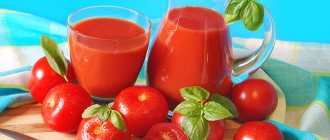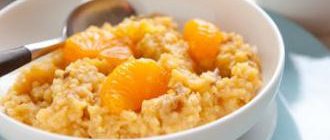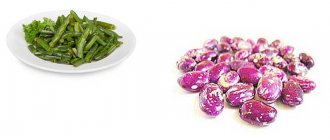Medicinal properties
Tomatoes are good for the body because they have very low calorie content and at the same time contain a large amount of purines. Therefore, it is recommended to eat fresh fruits for those who suffer from excess weight and want to lose it, as well as for those whose ailments are caused by salt deposition.
For human health, tomatoes are useful for various disorders of natural metabolic processes, including diabetes and various forms of obesity, and for weight loss. The juice of this fruit can relieve all sorts of digestive problems and liver ailments, but, in addition, it has a pronounced diuretic effect, which helps fight edema, and is excellent at driving bile, so they are also useful during pregnancy.
Due to the content of lycopene, tomatoes can be considered a natural antioxidant, because this substance is literally several times superior in its healing properties to the well-known vitamin C.
For women, fresh tomatoes are useful because they help prevent the occurrence of cervical cancer, and protect men from possible prostate adenoma.
Some properties are significantly enhanced by consuming boiled and stewed tomatoes, for example, tomato paste or prepared in their own juice. Such products contain much more lycopene than fresh fruits and juice.
Tomato jam also retains some of its properties, but due to the high sugar content, the product is no longer dietary and cannot be consumed by diabetics.
It is also important to remember that our body is able to absorb the maximum number of useful substances from tomatoes if we consume the fruits together with vegetable oil. Therefore, a salad of fresh tomatoes with a dressing of natural olive oil is often recommended for various types of medical nutrition.
A little more about the benefits
Eating red vegetables, especially tomatoes, has a very significant effect on the functioning of the circulatory system, for example, normalizing the natural composition of the blood, healing it and helping to prevent vascular thrombosis.
Yellow tomatoes, no matter how unusual they are, are literally several times superior in their beneficial qualities to their usual red counterparts.
Such fruits have a much lower acidity level, so they can be consumed by people with gastritis and other ailments. They are safe for allergy sufferers, have lower calorie content and are much healthier for diabetics than red ones. Due to the large amount of essential dietary fiber, they perfectly improve intestinal motility, enhance the functioning of the digestive system, and perfectly eliminate constipation.
But green fruits cannot be eaten raw, since they contain a harmful toxin called solanine in quite high concentrations.
Some people prepare unripe tomatoes by pickling or canning, since cooking destroys the toxin, but the benefits of such a diet are very questionable.
Pickled tomatoes have a very low calorie content and are often used in the diet for weight loss, but due to the use of vinegar, some of the vitamins in the fruit are destroyed, although canned tomatoes still retain most of the benefits, including lycopene, so all the advantages can rightly be attributed to them fresh tomatoes.
But it is also important to note that regular consumption of small amounts of canned fruits significantly reduces the risk of heart disease and strengthens the immune system. Brine helps relieve headaches.
Salted tomatoes, especially pickled barrel ones, retain all the benefits of fresh fruits, but their consumption additionally protects the body from possible diseases of the prostate and pancreas.
Small cherry tomatoes have all the same properties as their large-fruited counterparts, but are distinguished by a higher sugar content, which makes their taste sweeter and unforgettable. They also contain all the vitamins we need, so cherry salads are even included in children's menus.
Sun-dried tomatoes have a higher calorie content, so they can only be consumed in small quantities during dietary nutrition. They perfectly improve memory and brain function. This product is a wonderful remedy for depression; it lifts your mood due to its serotonin content.
Tomatoes with garlic are often used in the fight against colds and various viruses, since, in addition to saturating the body with vitamins, such a dish also helps eliminate pathogenic microflora.
A tomato salad with sour cream can no longer be called a dietary product, because such a dressing is quite high in calories. But sometimes you can please yourself with such a dish, because the benefits of tomatoes are completely preserved in it.
Tomato juice - calories
Tomato juice has been a favorite drink of a huge number of people for decades. The beneficial properties of tomato juice, including calorie content, are identical to tomatoes, but if you do not carry out any heat treatments and do not add other ingredients.
Properties of tomato juice
This drink is recognized as one of the most beneficial for humans, as it improves metabolism, and due to the content of coarse fiber, it cleanses the intestines of waste products, which can significantly improve the functioning of the digestive system. Tomato juice is useful, given the presence of lycopene, a natural antioxidant that does not disappear even after heat treatment. Thanks to this, the drink improves the functioning of the nervous system, heart and blood vessels, and also reduces the risk of cancer. It is recommended for diabetics to consume tomato juice as it has the ability to reduce sugar. The beneficial properties of this drink are also confirmed by official medicine, so doctors recommend their patients to drink 1 tbsp. per day for vitamin deficiency. Traditional healers offer a large number of recipes that include tomato juice. For example, to get rid of cholelithiasis, it is recommended to combine juice and cabbage brine in equal proportions.
Now let's move on to energy value. First, let’s find out how many calories are in natural tomato juice. If you do not add anything to the drink, then the energy value will be 21 kcal per 100 g. At the same time, it is worth considering that there are different varieties of tomatoes that differ in sweetness. It will be useful to know how many kcal are in canned tomato juice with salt. In this case, the value decreases and amounts to 17 kcal. However, during heat treatment, many useful substances are destroyed. Knowing the kcal/100 g of tomato juice, you can easily calculate any necessary value, for example, the calorie content of 1 glass or the calorie content of the dish that includes this drink.
Contraindications for tomato juice
It is not recommended to drink the drink if you have an individual intolerance to the components, as well as if you are allergic to red vegetables and fruits. It is worth considering the acid content, which can provoke the movement of stones. It is necessary to exclude the drink from the diet in case of stomach ulcers, cholecystitis and pancreatitis, and in case of food poisoning.
Calorie content, composition and nutritional value of tomatoes
The tomato is not only an incredibly juicy, tasty and colorful vegetable, it is also very beneficial for the human body. On store shelves or summer cottages you can find yellow, green, black and red tomatoes.
In the summer, the vast majority of the population eats tomatoes: this vegetable can be eaten fresh, added to first and second courses, and also prepared in salads. In winter, stores sell tomatoes grown in greenhouse conditions.
Of course, their taste characteristics and concentration of nutrients are less pronounced.
Composition, calorie content and nutritional value
Tomatoes contain the following elements:
- pectin;
- beta-carotene;
- vitamins A, C, K, B, E, H and nicotinic acids;
- macro- and microelements (potassium, sodium, cobalt, manganese, copper, iron, chromium, boron, molybdenum and magnesium).
The concentration of nutrients in tomatoes is very impressive. 100 grams of fresh product contains:
- proteins - 0.6 g;
- fats - 0.2 g;
- carbohydrates - 4.2 g.
As for the energy value of the vegetable, it varies depending on the type in which you consume the product. The calorie content of tomatoes in their own juice is significantly higher than in salted, pickled or juice.
Fresh fruits
Tomatoes first entered Russia at the beginning of the 19th century. Already, half a century later, this vegetable has become, perhaps, one of the most popular among Russians. Today, this crop is grown in almost every summer cottage. Tomatoes are versatile vegetables that are widely used in cooking and cosmetology.
Description
Tomatoes in their own juice make it possible to enjoy tasty and healthy vegetables at any time of the year, which is simply necessary in winter, when the body lacks many different vitamins and microelements. Most often, to make such preservation, varieties of tomatoes are used that have a plum-shaped shape and their size does not exceed a chicken egg. Some housewives use cherry tomatoes for this.
Today, tomatoes in their own juice can be prepared independently or bought in a store. It is very important to pay attention to the ingredients included in the product. Ideally, tomatoes in their own juice include: tomatoes, water and spices, and the latter may not even be used.
Beneficial features
This method of preservation makes it possible to preserve almost all vitamins and minerals. These vegetables contain lycopene, a substance that has the ability to reduce the risk of prostate cancer .
During the period of boiling tomatoes, the amount of lycopenes increases several times. This useful substance also serves as an excellent prevention of heart and vascular diseases, and it also prevents the development of diseases of the visual apparatus and oncology .
Considering the fact that the fruit contains a fairly large percentage of water, this product, among other things, can be used as a diuretic.
Use in cooking
Tomatoes in their own juice are very popular all over the world. This product can be used as an independent dish, which is suitable as an additional snack, for example, with a meat dish. In addition, tomatoes in their own juice can be used as ingredients for various dishes. They can easily replace tomato paste or sauce, only to do this they need to be brought to a homogeneous mass. If the resulting mixture is mixed with water, the result will be a tasty and, most importantly, healthy juice. Tomatoes in their own juice are added to first courses and meat dishes, casseroles and baked goods.
Read also Do-it-yourself children's sandbox with a lid
The benefits of tomatoes in their own juice and treatment
The benefits of tomatoes in their own juice are due to the preservation in them of almost all the beneficial substances found in fresh fruits. This product has an anti-inflammatory, diuretic, choleretic effect on the human body. In addition, tomatoes in their own juice have the ability to strengthen blood vessels, and they also prevent atherosclerosis .
In general, tomato juice contains a huge amount of microelements, vitamins and organic acids.
Harm of tomatoes in their own juice and contraindications
Tomatoes in their own juice can be harmful to people with individual intolerance. It is also worth remembering that these vegetables can cause allergies in some people, since red vegetables are the most active allergens. It is also worth limiting the consumption of this product in case of gout and during exacerbation of kidney disease .
Cooking recipes with photos
Solyanka with meat and sausage - delicious soup stewed in a frying pan
Tomatoes came from America under the sails of the conquistadors to conquer Europe. In Mexico's humid, warm climate, semi-cultivated tomato varieties still grow. Now tomatoes are successfully grown in greenhouses even in the northern regions. But you can get tasty and maximally fortified fruits only under the hot southern sun.
The time for consuming fresh ground tomatoes is limited to a few months, but you want to spread the pleasure throughout the whole year.
Ripe tomatoes canned with tomato juice are an impeccable tasty and healthy product, available all year round (calorizer). This method of preservation preserves almost all the vitamins that tomatoes are rich in.
Calorie content of tomatoes in their own juice
The calorie content of tomatoes in their own juice is 24 kcal per 100 grams of product.
Composition of tomatoes in their own juice
Tomatoes in their own juice contain biotin, beta-carotene, folic acid, thiamine and a host of other vitamins. The saturation of tomatoes with calcium, magnesium, phosphorus, and potassium is maintained by tomato juice. Without additional preservatives, these tomatoes are ideal in any diet.
But if vitamins and chemical elements can be obtained from many products, then the main source of lycopene in European countries are tomatoes, which contain 4/5 of the required amount.
Useful properties of tomatoes in their own juice
Once upon a time, the admiring French dubbed the juicy bright red fruit the “apple of love.” Paradoxically, the theme of love echoed in the medical discovery of the 20th century. It has already been proven that lycopene radically reduces the risk of prostate cancer, which is important for men’s health. Evaporation of tomato juice leads to an increase in the concentration of lycopene, increasing its medicinal properties. This product has an anti-inflammatory, diuretic, choleretic effect on the human body.
In addition, the fruit contains a fairly large percentage of water, so the product, among other things, can be used as a diuretic.
Tomatoes in their own juice in cooking
Tomatoes in their own juice are very popular all over the world (calorizator). This product can be used as an independent dish, which is suitable as an additional snack, for example, with meat. Also, tomatoes in their own juice can be used as ingredients for various dishes. They can easily replace tomato paste or sauce, but to do this they need to be brought to a homogeneous mass. If the resulting mixture is mixed with water, the result will be a tasty and, most importantly, healthy juice. Tomatoes in their own juice are added to first courses and meat dishes, casseroles and baked goods.
The most delicious recipe for tomatoes in their own juice
This recipe is my family's favorite, so we'll start with that. For this preparation, it is best to use ripe tomatoes. Moreover, not very beautiful ones will also do - they will be used for juice, with which we will pour selected beautiful tomatoes.
We will need:
- tomatoes (I don’t specifically indicate the exact quantity, but I had 4 kg)
For 1 liter of tomato juice:
- salt - 1.5 tbsp. l.
- sugar - 3 tbsp. l.
Pour 1 tbsp into each jar. l. apple cider vinegar
We sort the tomatoes. We divide all the tomatoes into approximately two parts. We select the smallest and most beautiful ones separately, we will put them in jars. And broken, large and uneven ones are suitable for tomato juice. As they say, waste-free production.
We cut off all questionable areas of damaged tomatoes; only healthy and fresh tomatoes should remain.
To prepare tomato juice, cut the tomatoes in half. This is for convenience; I grind them using a blender. You can use a juicer or a mixer - whichever is convenient for you.
It turned out 2 liters of juice. It must be brought to a boil. Pour the juice into a saucepan or basin, add 3 tbsp. l. salt and 6 tbsp. l. sugar, stir. After boiling, turn it off immediately.
First we must prepare clean liter jars and pour boiling water over the lids. Prepare more boiling water, we will make the first pouring of the tomatoes.
While the juice is boiling, put whole tomatoes into clean jars, pack them tightly so that there are fewer empty spaces. Fill each jar with boiling water.
To prevent tomatoes from bursting, each one can be pricked with a toothpick in the area of the stalk. Or you can cut off the tip with a knife.
Remember to be careful when pouring. To prevent the jar from cracking, pour just a little hot water into the bottom and wait a few seconds. Do not pour in all the water at once, but gradually.
Cover the top with a lid and wait for 5 minutes, letting the contents of the jar sterilize a little. We drain the water.
Immediately, before the tomato juice has cooled, pour it into the jar up to the neck. Pour 1 tbsp directly into the jar. l. apple cider vinegar.
Cover each jar with a lid and roll it up. Be sure to turn it upside down, wrap it in a blanket and leave it until it cools completely.
Canning tomatoes at home without sterilization
Everyone probably loves simple and quick recipes. Housewives always have a lot to do, and if we can find a simple recipe without any problems, then we are happy to save time when cooking. But this will not affect the taste of our preparation. Let's get started.
We will need:
- tomatoes
For 1 liter of tomato juice:
- salt - 1 tbsp. l.
- sugar - 1 tsp.
For 2 kg of tomatoes you will need approximately 1 liter of tomato juice. And in order to get 1 liter of juice, you will need 1.2-1.5 kg of tomatoes, depending on the variety.
For juice we will use large yellow tomatoes, and put small plum tomatoes in jars.
Tomato juice can be squeezed out using a juicer, blender or even a meat grinder. To do this, cut the tomatoes into pieces and put them in a juicer. Pour the resulting juice into a saucepan, add salt and sugar. Bring to a boil and simmer over low heat for 10 minutes. Foam will form which can be removed, although this is not necessary.
A simple recipe for a 1 liter jar of garlic
I want to share another simple recipe for preparing tomatoes. In principle, the composition of the marinade is similar to previous recipes. Just add garlic, bay leaf and allspice. For flavor, add cinnamon and cloves to the tomato juice. We will pour the required amount of salt and sugar directly into the jar, very quickly and conveniently. We will use large, fleshy tomatoes in the recipe. And so that they fit in the jar, we cut them into slices.
We will need:
- tomatoes (about 1.5 kg in 3 liter jars and about 2 kg for juice)
- black peppercorns
- Bay leaf
- allspice
- garlic
- cinnamon
- carnation
For 1 liter jar:
- salt - 1 tbsp. l.
- sugar - 1 tsp.
- vinegar - 1 tsp.
There are recipes in which tomato paste is diluted instead of natural tomato juice. I don’t want to describe them, it seems to me that the results are not as tasty and aromatic as with homemade juice. This recipe requires approximately 1.5 liters of juice for 3 liter jars.
Tomatoes for juice are cut into slices and crushed with a mixer, juicer, meat grinder or rubbed through a sieve. Choose any available and favorite method. I prefer a mixer. Bring the tomatoes to a homogeneous mass. It turns out not even juice, but tomato puree. Pour it into a saucepan, add cinnamon and cloves. Bring to a boil and cook for 10 - 15 minutes over low heat.
During cooking, do not forget to stir the juice, otherwise it may burn and remove the foam.
While the juice is preparing, put spices and a couple of cloves of garlic on the bottom of sterilized jars. Add tomatoes cut into large pieces. Fill the jars with hot water, preferably from a kettle. Cover with lids and leave to pasteurize for 10 minutes. We drain the water.
Now add 1 teaspoon each of salt, sugar and 9% vinegar directly into the jar.
You can omit vinegar for this recipe, but then you will have to sterilize the jars along with the tomatoes.
Pour the finished hot juice over the tomatoes again, immediately screw on the metal lid and turn the jar over.
As you can see, everything is simple. And after a few days you can enjoy a delicious snack.
Tomato juice and weight loss
Here are some facts according to which tomato juice is considered beneficial for those who want to lose a few extra pounds. There were no cases of harm to weight loss.
Low-calorie, tasty, filling.
Organizes metabolism.
Thanks to the beneficial substances, vitamins, micro and macroelements contained in tomato juice, it has a positive effect on the absorption of food and digestion in general.
Stimulates the production of seratonin, which is responsible for mood in the body. Serotonin increases and mood improves.
Often, those who want to lose weight are interested in the question: “Is it possible to gain weight from tomato juice?” The answer is “no,” because on the contrary, it improves digestion, metabolism, accelerates metabolism, which has a weight-loss effect.
Read also: How to pickle green vegetables in jars for the winter
Finger-licking tomatoes without peel and marinade
Tomatoes can be canned without marinade. After we cut them into slices, they will give a lot of juice. So why another marinade? And in order for their taste to be more delicate, let’s remove the skin from the tomatoes.
We will need:
- tomatoes
For 1 liter jar:
- salt - 1 tbsp. l.
- sugar - 1 tsp.
- vinegar - optional 1 tbsp. l.
We will need to remove the skin from the tomatoes. To make this easier, make a crosswise cut on the tomato with a sharp knife.
Pour boiling water over the tomatoes. After this, the skin comes off very easily.
Now cut the tomatoes into pieces.
The jars for this recipe do not need to be sterilized first; just rinse them with baking soda. Place the tomatoes tightly in clean jars and press lightly with a spoon. You will see how much juice appears in the jar. It should cover the top of the jar.
Pour 1 tbsp into the top of the jar. l. salt and 1 tsp. Sahara. Many people love sweet marinade. In this case, you can add sugar as well as salt, 1 tbsp. l.
Place the jar in a pan of hot water to sterilize. Be sure to cover with a boiled lid. Before doing this, place a towel or napkin on the bottom of the pan. You need to boil for about 15 minutes.
At the end of sterilization, you can add 1 s. l. vinegar. Although, again, this is not necessary. If all sterilization conditions are met, the jars will stand without vinegar. And then you will get the taste of a natural vegetable.
In fact, you will lick your fingers!
Cooking tomatoes in their own juice with bell peppers
If you add bell pepper to the marinade, the appetizer will receive a special flavor. I think it's worth trying and adding one more variety to our recipes. I hope you like it. This recipe also does not have exact quantities - add all ingredients to taste.
We will need:
- tomatoes
- salt
- bell pepper
- celery leaves
- garlic
- Bay leaf
- black peppercorns
Let's prepare the jars in advance; we need to rinse them well with soda and dry them. It is advisable to boil the lids.
We select small, beautiful tomatoes that we will place in jars. We pierce each tomato with a knife at the stalk.
Place peppercorns, bay leaves and fresh celery leaves at the bottom of the jar.
Place the tomatoes tightly in the jar. I try to place the largest fruits at the bottom of the jar, and the smallest ones on top. We insert a couple of garlic cloves inside the jar.
Pour boiling water over the contents of the jars, cover with a lid and leave to sterilize for 20 minutes. Drain the water and fill it again with another batch of boiling water for another 10 minutes.
At this time, prepare tomato juice. Grind the tomatoes using a blender until smooth.
Micro- and macroelements in Tomatoes in their own juice
Tomatoes in their own juice contain the following elements: Mono- and disaccharides, Ash, Starch, Water, Organic acids, Dietary fiber, Sodium, Potassium, Phosphorus, Magnesium, Calcium, Sulfur, Copper, Boron, Iodine, Manganese, Chromium, Fluorine, Molybdenum , Cobalt, Nickel, Rubidium, Zinc, Iron, Chlorine.
Micro- and macroelementValue
| Mono- and disaccharides, g. | 3,5 |
| Zola, Mr. | 0,7 |
| Starch, Mr. | 0,3 |
| Water, city | 93,5 |
| Organic acids, g. | 0,5 |
| Dietary fiber, g. | 0,8 |
| Sodium, mg | 40 |
| Potassium, mg | 290 |
| Phosphorus, mg | 26 |
| Magnesium, mg | 20 |
| Calcium, mg | 14 |
| Sulfur, mg | 12 |
| Copper, µg | 110 |
| Boron, µg | 115 |
| Iodine, mcg | 2 |
| Manganese, mg | 0,14 |
| Chromium, µg | 5 |
| Fluorine, mcg | 20 |
| Molybdenum, mcg | 7 |
| Cobalt, µg | 6 |
| Nickel, µg | 13 |
| Rubidium, mcg | 153 |
| Zinc, mg | 0,2 |
| Iron, mg | 0,9 |
| Chlorine, mg | 57 |
Tomato juice: benefits and harms, calorie content, use during diet
For several centuries, tomato juice has been considered one of the important products in the diet of people living in many countries of the world. This is explained by its unique vitamin composition and beneficial properties for the human body. Tomato products play a special role in dietary nutrition due to their low calorie content and high nutritional value. The most healthy option is the homemade juice, which is prepared without adding salt. If it is impossible to consume a natural product, you are allowed to drink a purchased one, which is currently produced on an industrial scale and represented by several companies. Each of them has its own production technology.
The benefits of the product for the human body are due to the high content of vitamins and minerals:
| Components | Approximate amount per 100 grams | |
| Vitamins |
| |
| Microelements |
| |
| Macronutrients |
| |
| Cellulose | Not less than 0.5 g | |
| Sugar | No more than 3-4 g in different varieties | |
| Organic acids | About 0.4 g | |
| Ash | About 1.3-1.5 g | |
| Water | Almost 93% | |
The nutritional value of tomato juice is determined by the amount of proteins, fats and carbohydrates: 0.7/0.3/3.5 g for every 100 ml of product.
Energy value per 100 ml:
- homemade tomato juice – approximately 18-19 kcal;
- product with added salt – 20-25 kcal;
- popular packaged juice “Dobry” – 22 kcal.
1 glass of tomato juice contains from 40 to 60 kcal, 1 cup up to 200 ml contains from 36 to 50 kcal.
Compound
The composition of tomato juice is impressive. There are few vegetables that contain so many healthy substances. It contains minerals, vitamins, organic acids, sugars and other substances necessary for health.
Chemical composition:
- vitamins – C, A, H, PP, E, B;
- microelements – iron, iodine, cobalt, manganese, boron, copper, fluorine, chromium, rubidium, nickel, molybdenum, zinc, selenium;
- macroelements – phosphorus, sodium, chlorine, potassium, magnesium, sulfur, calcium;
- organic acids – citric, malic, oxalic, tartaric, succinic, lysine;
- sugars – fructose, glucose;
- pigments – lycopene;
- alimentary fiber;
- pectin.
The rich chemical composition explains the beneficial properties of tomato juice. Minerals and vitamins play an important role in human life. With their deficiency, health problems begin. Sugars replenish energy costs. Dietary fiber promotes satiety. With all this, tomato juice has low calorie content. It is only 18 kcal. This feature makes it one of the products included in weight loss diets.
In terms of mineral content, tomatoes are record holders among vegetables.
Calorie content of tomato juice from different manufacturers
When talking about the beneficial properties of tomato juice, we most often mean juice produced at home, which is why the question of how many calories are in homemade tomato juice is the most pressing, although some manufacturers offer a tasty product rich in vitamins and minerals. The calorie content of tomato juice without salt is 17 kcal per 100 grams of drink, and in a glass of juice, accordingly, there are approximately twice as many calories. Since we are already talking about salt, we should answer the question of how many calories are in tomato juice with salt. Although salt is not considered a high-calorie product, it “weights” the drink by 4-5 calories.
Today, tomato juice is offered by many domestic manufacturers, but the most popular of them are the juices of the famous Dobry brand, therefore, speaking about industrially produced juices, first of all, we should talk about how many calories are in Dobry tomato juice. 100 grams of this juice contains 22 calories.
The calorie content of juices differs slightly from other manufacturers, so when talking about how many calories are in tomato juice Favorite, experts settled on 19 kilocalories.
If you remember how many calories are in tomato juice from Orchard, which is also very popular, then we are talking about 22 calories contained in 100 grams of juice. Housewives often use tomato paste to prepare various dishes - this is the same tomato juice, but in concentrated form. It remains to answer the question of how many calories are in tomato juice from tomato paste. On average, this is 25-30 kcal, but it all depends on the consistency of the juice and the amount of paste, since the paste itself contains about 90 kilocalories in 100 grams.
Beneficial features
What are the health benefits of tomato juice? First of all, it is a source of substances necessary for health, such as vitamins and microelements. The benefit of tomato juice also lies in its ability to have an antioxidant effect on the body and slow down the aging process. He owes this to lycopene.
Organic acids participate in the regulation of acid-base balance, reduce the risk of developing cancer, and slow down the aging process. Pectin cleanses blood vessels from cholesterol, toxins, and promotes digestion.
Tomato juice tones, lifts your mood, and promotes the formation of serotonin, which is known to be the “happiness” hormone.
The benefits of tomato juice for women have been proven. It relieves symptoms of PMS, helps to survive a difficult menopause, and tones. A large number of vitamins and minerals help maintain the beauty of skin, nails, and hair. The drink also slows down the aging process and helps get rid of extra pounds.
The benefits of tomato juice for weight loss are explained by its chemical composition and low calorie content. Dietary fiber and pectin promote cleansing, speed up metabolism, and saturate. Vitamins and minerals help maintain health and promote fat burning.
Tomato juice is also beneficial for men. It protects the prostate gland and helps restore sexual function.
Interesting fact! Boiled tomatoes turn out to be healthier than raw ones! When heated, the amount of lycopene increases.
Tomatoes promote weight loss
Useful properties of tomato juice
All these substances and elements contained in tomatoes have a positive effect on all organs and systems of the human body.
Potassium – normalizes the functioning of the central nervous system and makes it more productive. It also regulates the rhythm of the heartbeat.
Sodium – controls and normalizes water balance in the body.
Magnesium – takes part in the process of protein synthesis and enzymatic processes. It is good for teeth, controls the rhythm of heart contractions, and plays an important role in the functioning of the muscular system.
Calcium – fights excess cholesterol, normalizes the functioning of the endocrine system, affects blood clotting.
Phosphorus - takes part in the metabolic process, participates in the functioning of the kidneys, the central nervous system, and affects the formation of bones.
Iron – is involved in the production of hemoglobin, enzymes and myoglobin.
Read also Squid in milk sauce
Vitamin A – has an antioxidant effect. Good for vision, bones, skin and immunity.
Thiamine – performs a protective function for cell membranes from the influence of toxic substances. Participates in all metabolic processes of the body.
Riboflavin is indispensable in the synthesis of antibodies, enzymes and red blood cells.
Choline – lowers cholesterol levels, has a protective effect on cell membranes, an antidepressant.
Vitamin C – is involved in the process of growth and division of vascular cells, tissues and bones. Improves iron absorption. Good for immunity.
Pectin – fights excess cholesterol, normalizes the functioning of the circulatory system, in particular blood circulation, and cleanses the body of toxins.
Lycopene is an antioxidant that effectively fights free radicals. It has a strengthening effect on the immune system, the walls of blood vessels, and is involved in cholesterol metabolism and digestive processes.
Fiber – helps get rid of toxic substances, normalizes cholesterol, normalizes intestinal microflora.
Application
The benefits and harms of tomato juice largely depend on the method of its use. It should not be abused. Excess has never been good for health. You should also not drink juice for certain diseases and for certain categories of people.
Rules of application
In order for the drink to be beneficial and not harmful, you must follow the following rules for its use:
- It should not be drunk on an empty stomach. The acids contained in it will corrode the stomach wall and can contribute to the development of gastritis.
- It is not advisable to combine tomatoes with proteins and starches. This will contribute to the development of urolithiasis.
- It is better to drink it half an hour before meals. This way it will be better absorbed, but will not harm the stomach.
- You should not abuse the drink. The norm is a couple of glasses a day.
- It is better to drink unsalted juice, as it will bring more benefits.
- If you have chronic diseases, it is advisable to consult a doctor before use.
- Tomato juice for weight loss is drunk between meals or instead of them. Salt should be avoided during the diet.
Advice! Tomato juice should not be drunk in painful conditions. It can increase pain sensitivity.
Contraindications
Not everyone can drink tomato juice. In case of exacerbations of chronic diseases, it is worth abandoning it, or significantly reducing the amount.
You should not drink tomato juice if you have pancreatitis, cholecystitis, or peptic ulcers. Gastritis and gout are also contraindications for use.
Tomatoes are the only vegetable that when heated only increases its usefulness
Harm of tomato juice
Despite the many beneficial properties, tomato juice has contraindications. Drinks with salt should be avoided if you have diseases of the kidneys, liver, or pancreas. In some people, tomato juice provokes flatulence, bloating, and allergic reactions.
The product is also contraindicated for stomach ulcers, high acidity of gastric juice, urolithiasis, and inflammation of the bladder. Nutritionists do not recommend drinking tomato juice on an empty stomach. In this case, it can cause heartburn.
SUBSCRIBE TO SITE UPDATES
Cooking recipes
Tomato juice can be bought ready-made in the store, but making your own drink will be of great benefit.
Tomato juice
Preparing tomato juice is quite simple using a juicer or blender. To do this, the fruits are scalded with boiling water and the skins are removed. Then they cut it into small pieces and put it in a juicer. It is best to drink it fresh, without salt, but you can put it in the refrigerator for a while. Shake before use. A healthy drink can be prepared for future use in the winter. To do this, it is brought to a boil and poured hot into jars. Roll up using a machine.
Sources
- https://dachka-ogorodik.ru/polezne-svoystva-rasteniy/pomidory-polyza-i-vred.html
- https://sport-at-home.ru/tomaty-v-sobstvennom-soku-kalorijnost-i-pishhevaya-cennost.html
- https://scastje-est.ru/pomidory-v-sobstvennom-soku.html
- https://BonFit.ru/kalorii/ovoshchi-i-zelen/tomaty/kalorii-tomaty-v-sobstvennom-soku/
- https://priroda-znaet.ru/polza-i-vred-tomatnogo-soka/
[collapse]










